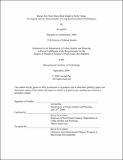| dc.contributor.advisor | David M. Geltner. | en_US |
| dc.contributor.author | Pai, Arvind | en_US |
| dc.contributor.other | Massachusetts Institute of Technology. Dept. of Urban Studies and Planning. | en_US |
| dc.date.accessioned | 2007-06-27T20:25:22Z | |
| dc.date.available | 2007-06-27T20:25:22Z | |
| dc.date.copyright | 2005 | en_US |
| dc.date.issued | 2006 | en_US |
| dc.identifier.uri | http://dspace.mit.edu/handle/1721.1/37426 | en_US |
| dc.identifier.uri | http://hdl.handle.net/1721.1/37426 | |
| dc.description | Thesis (S.M.)--Massachusetts Institute of Technology, Dept. of Urban Studies and Planning, September 2006. | en_US |
| dc.description | This electronic version was submitted by the student author. The certified thesis is available in the Institute Archives and Special Collections. | en_US |
| dc.description | Includes bibliographical references (leaves 58-59). | en_US |
| dc.description.abstract | This thesis presents an inquiry into the historical performance of core institutional real estate investment property during the 1984-2003 period. The focus of the analysis is on identifying systematic determinants of long run investment performance. The analysis seeks to increase our understanding of equilibrium asset pricing within this asset class, as well to provide some useful perspective for core portfolio strategic or tactical planning. This thesis extends earlier research by Geltner (1999) and Li and Price (2005) that indicated that a classical single-factor CAPM accurately modeled the cross-section of long-run total returns across the major asset classes, including real estate. The present thesis narrows that earlier focus to concentrate on the cross-section of long-run total return performance within the core institutional real estate asset class. This thesis uses the property level data of the NCREIF Index to construct portfolios and historical return indexes based on property size (value), and based on CBSA "tier" (that is, "upper", "middle", and "tertiary" cities from an institutional investment perspective). By using unique portfolios created from the NCREIF property set that represent possible factors that systematically affect asset pricing, such as property location, property size and property type, and calculating their beta estimates from historical data, this thesis tests various CAPM models including the single factor Sharpe-Linter model, as well as a multi factor Fama-French-like model. The beta for the portfolios was defined with respect to the performance of the aggregate of all NCREIF properties. This thesis finds that an equilibrium asset pricing model consisting of the two Fama-French-like factors, property size and MSA tier, plus property type dummy variables, explains some 90% of the long-run historical cross-section of core property portfolio returns. Interestingly, the "market factor", the beta with respect to aggregate NCREIF, is found to be insignificant, and possibly a negative influence on expected return. Furthermore, the size factor works opposite to the way it does in the stock market, with larger properties commanding an expected return premium. Surprisingly, the city "tier" factor gives an expected return premium to upper tier cities. Tests for an "income factor" (similar to the Fama-French book-to-market factor) found this factor to be insignificant. The most significant factor was found to be the property type. Thus, the equilibrium asset price model that seems to work well within the institutional core real estate asset class seems to be very different from, almost opposite to, the analogous model within the stock market. | en_US |
| dc.description.statementofresponsibility | by Arvind Pai. | en_US |
| dc.format.extent | 80 leaves | en_US |
| dc.language.iso | eng | en_US |
| dc.publisher | Massachusetts Institute of Technology | en_US |
| dc.rights | M.I.T. theses are protected by copyright. They may be viewed from this source for any purpose, but reproduction or distribution in any format is prohibited without written permission. See provided URL for inquiries about permission. | en_US |
| dc.rights.uri | http://dspace.mit.edu/handle/1721.1/37426 | en_US |
| dc.rights.uri | http://dspace.mit.edu/handle/1721.1/7582 | |
| dc.subject | Urban Studies and Planning. | en_US |
| dc.title | Stocks are from Mars, real estate is from Venus : an inquiry into the determinants of long-run investment performance | en_US |
| dc.title.alternative | Inquiry into the determinants of long-run investment performance | en_US |
| dc.type | Thesis | en_US |
| dc.description.degree | S.M. | en_US |
| dc.contributor.department | Massachusetts Institute of Technology. Department of Urban Studies and Planning | |
| dc.identifier.oclc | 123193396 | en_US |
